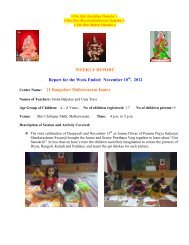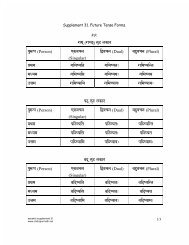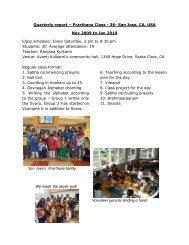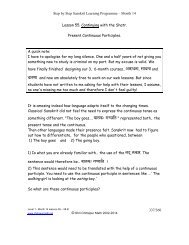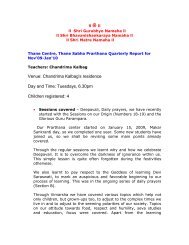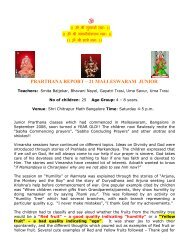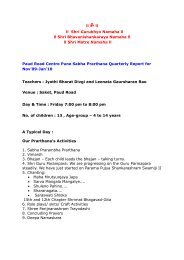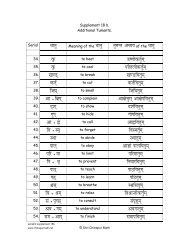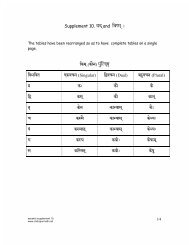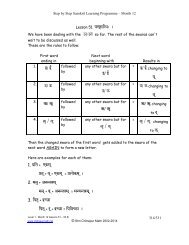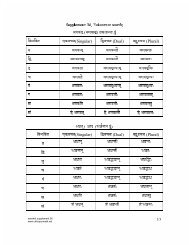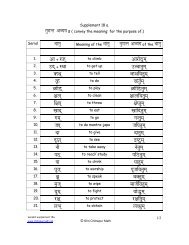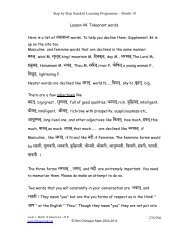Month 4 - Shri Chitrapur Math
Month 4 - Shri Chitrapur Math
Month 4 - Shri Chitrapur Math
- No tags were found...
Create successful ePaper yourself
Turn your PDF publications into a flip-book with our unique Google optimized e-Paper software.
Step by Step Sanskrit Learning Programme – <strong>Month</strong> 4Buffet Lesson 18 A. Exercises with the Saptami.Nouns Verbs AvyayasˆÅø«Ú room Mœþþ°þ vessel/plate Nˆ¼Å«µþûÅ¥þˆÅblackboard Mªþú·þœø¹ÙˆÅþrefrigerator F‚þ¬þ›¸ chair M¸µÛ¸úœþ tube-light M¨¡þþ›þ fan N„·œþú¹ÚˆÅþ Table FˆÅœþþÙ Cupboard Nœø¹ÙˆÅþ Suitcase FŸþØþ bed MœþþþˆÅ PressureCooker/ also a cook! Ms¼[k Computer Mþ«þˆÅ glass ( what youdrink from.)MˆºÅÙºŸþ family NœÏþ·þ:ˆÅþ¥þ morning MŸþš¡þþí›þ afternoon M¬þþ¡þ¿ˆÅþ¥þ evening M¹¸›þ day N¹›þªþþ night.F¹¬›þà (¹¬›þàþ¹·þ ) to love.¬˜þþ ( ¬˜þþœþ¡þ¹·þ ) tokeep/ to place.¬˜þþ ( ¹·þ«Ú¹·þ ) to standor wait.œþúÛà ( œþúÛ¡þ¹·þ) totrouble.Level 1 - <strong>Month</strong> 4 lessons 18-23 Dwww.chitrapurmath.net © <strong>Shri</strong> <strong>Chitrapur</strong> <strong>Math</strong> 2002-2014120/166
Step by Step Sanskrit Learning Programme – <strong>Month</strong> 41. In the morning, I go to school.2. In the night, I sit on my bed.3. In Sharada's hand is a fruit.4. The milk is in the glass.5. The girl throws her clothes from the cupboard into the suitcase.6. That man loves his (two) sons.7. The two sons love the father.8. The tube-lights are in the room.9. The vegetables are in the refrigerator.10. In the evening, the shopkeeper is reading in his shop.11. Kavita's meal is on her plate.12. The blackboard is in school.13. Clouds are in the sky.14. Water is in the lake.15. The question is in the computer and not in the book.16. I put the rice in the pressure cooker.17. The milk is in the milk-vessel.18. In the night, I am sitting in the restaurant on a chair and eating food.19. In the day, Mickey Mouse and Donald Duck are walking in Disneyland.20. Vijay's shop is in the village.21. Anuraag is sitting with Prerna in the cinema.22. I am drinking the water from the tumbler.23. The teacher is strolling in the garden with his students.24. Naresh lives in the forest with his family.Level 1 - <strong>Month</strong> 4 lessons 18-23 Dwww.chitrapurmath.net © <strong>Shri</strong> <strong>Chitrapur</strong> <strong>Math</strong> 2002-2014121/166
Step by Step Sanskrit Learning Programme – <strong>Month</strong> 4Buffet Lesson 18 B. Answers to Lesson 18 A.1. In the morning, I go to school. œÏþ·þ:ˆÅþ¥ø ‚−¿ œþþÚªþþ¥þþ¿ ŠþŽþ¹Ÿþ |2. In the night, I sit on my bed. ¹›þªþþ¡þþŸþà ‚−¿ ŸþŸþ ŸþØø „œþ¹¨þªþþ¹Ÿþ |3. In Sharada's hand is a fruit. ªþþ£¸þ¡þþ: −¬·ø ûÅ¥þŸþà ‚¹¬·þ |4. The milk is in the glass. ¸ºŠšþ¿ þ«þˆ½Å ‚¹¬·þ |5. The girl throws her clothes from the cupboard into the suitcase.þþ¹¥þˆÅþ ˆÅœþþÙþ·þà œø¹ÙˆÅþ¡þþ¿ ·þ¬¡þþ: ¨þ¬°þþ¹µþ ¹âþœþ¹·þ|6. That man loves his (two) sons. ¬þ: ›þ£: ·þ¬¡þ œé°þ¡þø: ¹¬›þàþ¹·þ |7. The two sons love the father œé°þù þ›þˆ½Å ¹¬›þàþ·þ: |8. The tube-lights are in the room. ¸µÛ¸úœþþ: ˆÅø«Ú½ ¬þ¹›·þ|9. The vegetables are in the refrigerator. ªþþˆÅþ: ªþú·þœø¹ÙˆÅþ¡þþ¿ ¬þ¹›·þ|10. In the evening, the shopkeeper is reading in his shop. ¬þþ¡þ¿ˆÅþ¥ø ‚þœþ¹µþˆÅ:·þ¬¡þ ‚þœþµø œþÚ¹·þ |11. Kavita's meal is on her plate. ˆÅ¹¨þ·þþ¡þþ: žþøþ›þ¿ ·þ¬¡þþ: œþþ°ø ‚¹¬·þ|12. The blackboard is in school. ˆ¼Å«µþûÅ¥þˆÅ: ¹¨þÔþþ¥þ¡ø ‚¹¬·þ|13. Clouds are in the sky. Ÿø‹þþ: ‚þˆÅþªø ¬þ¹›·þ |14. Water is in the lake. þ¥þ¿ ¬þ£ø¨þ£½ ‚¹¬·þ |15. The question is in the computer and not in the book. œÏª›þ: s¼[ˆ½Å ‚¹¬·þ ›þœé¬·þˆ½Å|16. I put the rice in the pressure cooker. ‚−Ÿþà ‚››þ¿ œþþþˆ½Å ¬˜þþœþ¡þþ¹Ÿþ|17. The milk is in the milk-vessel. ¸ºŠšþ¿ ¸ºŠšþœþþ°ø ‚¹¬·þ |18. In the night, I am sitting in the restaurant on a chair and eating food.¹›þªþþ¡þþŸþà „œþþ−þ£Šþ¼−½ ‚−Ÿþà ‚þ¬þ›¸½ „œþ¹¨þªþþ¹Ÿþ žþøþ›þ¿ þ ‰þþ¸þ¹Ÿþ|19. In the day, Mickey Mouse and Donald Duck are walking in Disneyland.¹¸›ø ¹Ÿþ¹ˆÅŸþù¬þà (!) Ûß›þÌÛ ÛˆÃÅ (!) þ ¹Û¹›þ¥ß›Û½ þ¥þ·þ: |(Yes, i do pronounce the "s" in Disneyland like a "z"... i just can't seem to write it inSanskrit!)20. Vijay's shop is in the village. ¹¨þþ¡þ¬¡þ ‚þœþµþ: ŠÏþŸø ‚¹¬·þ|21. Anuraag is sitting with Prerna in the cinema. ‚›é£þŠþ: œÏ½£µþ¡þþ ¬þ− ¹þ°þœþÙŠþ¼−½„œþ¹¨þªþ¹·þ |22. I am drinking the water from the tumbler. ‚−¿ þ«þˆÅþ·þà þ¥þ¿ ¹œþþþ¹Ÿþ|23. The teacher is strolling in the garden with his students. ‚š¡þþœþˆÅ: Žþ°þ¾:¬þ− „Ôþþ›ø žÏŸþ¹·þ |24. Naresh lives in the forest with his family. ›þ£½ªþ: ˆºÅÙºŸø›þ ¬þ− ¨þ›ø ¨þ¬þ¹·þ |Level 1 - <strong>Month</strong> 4 lessons 18-23 Dwww.chitrapurmath.net © <strong>Shri</strong> <strong>Chitrapur</strong> <strong>Math</strong> 2002-2014122/166
Step by Step Sanskrit Learning Programme – <strong>Month</strong> 4ˆÅø«Ú room Mœþþ°þ vessel/plate Nˆ¼Å«µþûÅ¥þˆÅblackboard Mªþú·þœø¹ÙˆÅþBanquet Lesson 18 C. Exercises with the ¬þœ·þŸþú ¹¨þžþ¹Æ·þ |refrigerator F‚þ¬þ›¸ chair M¸µÛ¸úœþ tube-light M¨¡þþ›þ fan N„·œþú¹ÚˆÅþ Table FˆÅœþþÙ Cupboard Nœø¹ÙˆÅþ Suitcase FŸþØþ bed MœþþþˆÅ PressureCooker/ also a cook! Ms¼[k Computer Mþ«þˆÅ glass ( what youdrink from.)MˆºÅÙºŸþ family NœÏþ·þ:ˆÅþ¥þ morning MŸþš¡þþí›þ afternoon M¬þþ¡þ¿ˆÅþ¥þ evening M¹¸›þ day N¹›þªþþ night.FNouns Verbs Avyayas¹¬›þà (¹¬›þàþ¹·þ ) to love.¬˜þþ ( ¬˜þþœþ¡þ¹·þ ) tokeep/ to place.¬˜þþ ( ¹·þ«Ú¹·þ ) to standor wait.œþúÛà ( œþúÛ¡þ¹·þ) totrouble.Level 1 - <strong>Month</strong> 4 lessons 18-23 Dwww.chitrapurmath.net © <strong>Shri</strong> <strong>Chitrapur</strong> <strong>Math</strong> 2002-2014123/166
Step by Step Sanskrit Learning Programme – <strong>Month</strong> 4The Goblin. ( ¨ø·þþ¥þ: | Remember ¹¨þÇÅŸþ: and the ¨ø·þþ¥þ: ?)1. I live with my family in my home.2. My home is in Mallapur.3. Mallapur is a village in Karnatak.4. In my home are my father, my mother, my brother, his wife, my sisterand her husband.5. In the morning, my mother goes to the kitchen.6. She cooks a meal .7. She puts the rice in the cooker.8. She puts the milk in the glasses and afterwards puts the glasses onthe table.9. The people of the family sit on chairs around the table and eat a meal.10. My father goes to the work place.11. My brother is a teacher.12. My sister is a teacher too.13. Her husband is a farmer.14. He goes to the field in the morning.15. I am a girl. I stay (wait) home.16. When my mother is in the kitchen, then I go to her room.17. I look in the cupboard.18. I take the clothes and the books from the cupboard and put them inthe suitcase.19. In the afternoon when my mother is in her room, then I go to thekitchen.20. I put the milk-vessel in the cupboard and the pressure cooker in therefrigerator.21. In the evening when the family's people are sitting around the tableand talking, I go to my father's room.22. I take his computer and put it in the bathroom.23. The blackboard is in the room.24. I write on it, " I am a goblin. This is my house.25. This family is living in my house.26. Therefore I am troubling the family's people."27. My mother thinks that there is a goblin in the house.28. She is scared of goblins.Level 1 - <strong>Month</strong> 4 lessons 18-23 Dwww.chitrapurmath.net © <strong>Shri</strong> <strong>Chitrapur</strong> <strong>Math</strong> 2002-2014124/166
Step by Step Sanskrit Learning Programme – <strong>Month</strong> 429. My father thinks that there are no goblins in the house.30. When my mother is in the kitchen at night, then he waits in his room.31. I go to his room and take his books.32. I put them on his bed.33. My father catches the goblin with his hands and gives her to his wife.34. My father tells his goblin that when goblins trouble people in thehouse, then fathers hit those goblins with sticks.35. I tell my father that this goblin is not troubling the family .36. My father and my mother laugh.37. They are not angry with the goblin.38. They love the goblin.39. I love my family too.Level 1 - <strong>Month</strong> 4 lessons 18-23 Dwww.chitrapurmath.net © <strong>Shri</strong> <strong>Chitrapur</strong> <strong>Math</strong> 2002-2014125/166
Step by Step Sanskrit Learning Programme – <strong>Month</strong> 4Banquet Lesson 18 D. Answers to Lesson 18 C.¨ø·þþ¥þ: |1. I live with my family in my home. ‚−¿ ŸþŸþ ˆºÅÙºŸø›þ ¬þ− ŸþŸþ Šþ¼−½ ¨þ¬þþ¹Ÿþ|2. My home is in Mallapur. ŸþŸþ Šþ¼−¿ Ÿþ¥¥þþœé£½ ‚¹¬·þ |3. Mallapur is a village in Karnatak. Ÿþ¥¥þþœé£: ˆÅµþþÄÙˆ½Å (‡ˆÅ:)ŠÏþŸþ: ‚¹¬·þ|4. In my home are my father, my mother, my brother, his wife, my sisterand her husband. ŸþŸþ Šþ¼−½ ŸþŸþ ¹œþ·þþ, ŸþŸþ Ÿþþ·þþ, ŸþŸþ žÏþ·þþ, ·þ¬¡þ žþþ¡þþÄ, ŸþŸþ žþ¹Šþ›þú, ·þ¬¡þþ:œþ¹·þ: þ ¬þ¹›·þ |5. In the morning, my mother goes to the kitchen. œÏþ·þ:ˆÅþ¥ø, ŸþŸþ Ÿþþ·þþ œþþˆÅŠþ¼−¿ŠþŽ¹·þ |6. She cooks a meal. ¬þþ žþøþ›þ¿ œþþ¹·þ|7. She puts the rice in the cooker. ¬þþ ‚››þ¿ œþþþˆ½Å ¬˜þþœþ¡þ¹·þ |8. She puts the milk in the glasses and afterwards puts the glasses onthe table. ¬þþ ¸ºŠšþ¿ þ«þˆ½Å«é ¬˜þþœþ¡þ¹·þ ·þ¸›þ›·þ£¿ þ«þˆÅþ›þà „·œþú¹ÚˆÅþ¡þþ¿ ¬˜þþœþ¡þ¹·þ |9. The people of the family sit on chairs around the table and eat a meal.ˆºÅÙºŸþ¬¡þ þ›þþ: „·œþú¹ÚˆÅþ¿ œþ¹£·þ: ‚þ¬þ›¸½«é „œþ¹¨þªþ¹›·þ, žþøþ›þ¿ ‰þþ¸¹›·þ þ |10. My father goes to the work place. ŸþŸþ ¹œþ·þþ ˆÅþ¡þþÄ¥þ¡þ¿ ŠþŽ¹·þ |11. My brother is a teacher. ŸþŸþ žÏþ·þþ ‚š¡þþœþˆÅ: |12. My sister is a teacher too. ŸþŸþ žþ¹Šþ›þú ‚¹œþ ‚š¡þþ¹œþˆÅþ ‚¹¬·þ|13. Her husband is a farmer. ·þ¬¡þþ: œþ¹·þ: ˆ¼Å«þˆÅ: |14. He goes to the field in the morning. ¬þ: œÏþ·þ:ˆÅþ¥ø âø°þ¿ ŠþŽ¹·þ |15. I am a girl. I stay (wait) home. ‚−¿ þþ¹¥þˆÅþ | ‚−¿ Šþ¼−½ ¹·þ«Úþ¹Ÿþ |16. When my mother is in the kitchen, then I go to her room. ¡þ¸þ ŸþŸþ Ÿþþ·þþœþþˆÅŠþ¼−½ ‚¹¬·þ , ·þ¸þ ‚−¿ ·þ¬¡þþ: ˆÅø«Ú¿ ŠþŽþ¹Ÿþ |17. I look in the cupboard. ‚−¿ ˆÅœþþÙ½ œþª¡þþ¹Ÿþ |18. I take the clothes and the books from the cupboard and put them inthe suitcase. ‚−¿ ¨þ¬°þþ¹µþ œé¬·þˆÅþ¹›þ þ ˆÅœþþÙþ·þà ›þ¡þþ¹Ÿþ œø¹ÙˆÅþ¡þþ¿ þ ¬˜þþœþ¡þþ¹Ÿþ|19. In the afternoon when my mother is in her room, then I go to thekitchen. Ÿþš¡þþí›ø ¡þ¸þ ŸþŸþ Ÿþþ·þþ ·þ¬¡þþ: ˆÅø«Ú½ ‚¹¬·þ, ·þ¸þ ‚−¿ œþþˆÅŠþ¼−¿ ŠþŽþ¹Ÿþ |20. I put the milk-vessel in the cupboard and the pressure cooker in therefrigerator. ‚−¿ ¸ºŠšþœþþ°þ¿ ˆÅœþþÙ½ , œþþþˆÅ¿ þ ªþú·þœø¹ÙˆÅþ¡þþ¿ ¬˜þþœþ¡þþ¹Ÿþ|21. In the evening when the family's people are sitting around the tableand talking, I go to my father's room. ¬þþ¡þ¿ˆÅþ¥ø ¡þ¸þ ˆºÅÙºŸþ¬¡þ þ›þþ: „·œþú¹ÚˆÅþ¿œþ¹£·þ: „œþ¹¨þªþ¹›·þ ¨þ¸¹›·þ þ, ‚−¿ ŸþŸþ þ›þˆÅ¬¡þ ˆÅø«Ú¿ ŠþŽþ¹Ÿþ|Level 1 - <strong>Month</strong> 4 lessons 18-23 Dwww.chitrapurmath.net © <strong>Shri</strong> <strong>Chitrapur</strong> <strong>Math</strong> 2002-2014126/166
Step by Step Sanskrit Learning Programme – <strong>Month</strong> 422. I take his computer and put it in the bathroom. ‚−¿ ·þ¬¡þ s'!g[k< ›þ¡þþ¹Ÿþ¬›þþ›þŠþ¼−½ þ ¬˜þþœþ¡þþ¹Ÿþ .23. The blackboard is in the room. ˆ¼Å«µþûÅ¥þˆÅ: ˆÅø«Ú½ ‚¹¬·þ|24. I write on it, " I am a goblin. This is my house." ‚−¿ ·þ¹¬Ÿþ›þà ¹¥þ‰þþ¹Ÿþ , " ‚−¿¨ø·þþ¥þ:| ‡·þ¸Ã ŸþŸþ Šþ¼−Ÿþà |25. This family is living in my house. ‡·þ¸Ã ˆºÅÙºŸþ¿ ŸþŸþ Šþ¼−½ ¨þ¬þ¹·þ |26. Therefore I am troubling the family's people ‚·þ: ‚−¿ ˆºÅÙºŸþ¬¡þ þ›þþ›þÃœþúÛ¡þþ¹Ÿþ|27. My mother thinks that there is a goblin in the house. ŸþŸþ Ÿþþ·þþ ¹þ›·þ¡þ¹·þ ¡þ·þÊþ¼−½ ¨ø·þþ¥þ: ‚¹¬·þ |28. She is scared of goblins. ¬þþ ¨ø·þþ¥þ½ž¡þ: žþ¡þŸþà ‚›éžþ¨þ¹·þ |29. My father thinks that there are no goblins in the house. ŸþŸþ ¹œþ·þþ ¹þ›·þ¡þ¹·þ¡þ·þà Šþ¼−½ ¨ø·þþ¥þþ: ›þ ¬þ¹›·þ|30. When my mother is in the kitchen at night, then he waits in his room.¡þ¸þ ŸþŸþ Ÿþþ·þþ ¹›þªþþ¡þþ¿ œþþˆÅŠþ¼−½ ‚¹¬·þ ·þ¸þ ¬þ: ·þ¬¡þ ˆÅø«Ú½ ¹·þ«Ú¹·þ |31. I go to his room and take his books. ‚−¿ ·þ¬¡þ ˆÅø«Ú¿ ŠþŽþ¹Ÿþ ·þ¬¡þ œé¬·þˆÅþ¹›þ›þ¡þþ¹Ÿþ þ |32. I put them on his bed. ‚−¿ ·þþ¹›þ ŸþØø ¬˜þþœþ¡þþ¹Ÿþ |33. My father catches the goblin with his hands and gives her to his wife.ŸþŸþ ¹œþ·þþ −¬·þþž¡þþ¿ ¨ø·þþ¥þ¿ šþ£¹·þ , ·þþ¿ þ ·þ¬¡þ žþþ¡þþÄ¡ù ¡þŽ¹·þ|34. My father tells his goblin that when goblins trouble people in thehouse, then fathers hit those goblins with sticks. ŸþŸþ ¹œþ·þþ ·þ¬¡þ ¨ø·þþ¥þþ¡þˆÅ˜þ¡þ¹·þ ¡þ·þà ¡þ¸þ Šþ¼−½ ¨ø·þþ¥þþ: þ›þþ›þà œþúÛ¡þ¹›·þ ·þ¸þ þ›þˆÅþ: ·þþ›þà ¨ø·þþ¥þþ›þà ¸µÛ¾: ·þþÛ¡þ¹›·þ|35. I tell my father that this goblin is not troubling the family. ‚−¿ ŸþŸþþ›þˆÅþ¡þ ˆÅ˜þ¡þþ¹Ÿþ ¡þ·þà ‡«þ: ¨ø·þþ¥þ: ˆºÅÙºŸþ¿ ›þ œþúÛ¡þ¹·þ |36. My father and my mother laugh. ŸþŸþ ¹œþ·þþ ŸþŸþ Ÿþþ·þþ þ −¬þ·þ: |37. They are not angry with the goblin. ·þù ¨ø·þþ¥þþ¡þ ›þ ˆºÅœ¡þ·þ: |38. They love the goblin. ·þù ¨ø·þþ¥ø ¹¬›þàþ·þ:|39. I love my family too. ‚−Ÿþà ‚¹œþ ŸþŸþ ˆºÅÙºŸø ¹¬›þàþþ¹Ÿþ|****************Level 1 - <strong>Month</strong> 4 lessons 18-23 Dwww.chitrapurmath.net © <strong>Shri</strong> <strong>Chitrapur</strong> <strong>Math</strong> 2002-2014127/166
Step by Step Sanskrit Learning Programme – <strong>Month</strong> 4Lesson 19. ¬þŸþøšþ›þ ¥þøÙà ¥þˆÅþ£ þ |My face is aching with smiling so much. The Cheshire Cat in "Through theLooking Glass, " couldn't have smiled any wider. With today's lesson, we areabsolutely, completely and irrevocably through with our vibhaktis!!!! ( Anyideas on how we may celebrate this momentous event? Send in yoursuggestions to "Purr-fectly Content Sanskrit Teacher atsanskrit@chitrapurmath.net )The ¬þŸþøšþ›þ is the form of word you use when you address someone.so we have," −½ £þŸþ, don't bug me.""þþ¹¥þˆ½Å, if you don't finish what's on your plate, there will be no televisionfor a week."" ‚š¡þþœþˆÅ, whatever you have just said has gone completely over my head!"Now it's no fun calling out to someone if you can't command or request himto do something for you. And so my dears, today you shall be introduced tothe ¥þøÙà ¥þˆÅþ£ (‚þ±þþ˜þÄ , The imperative mood.)New Concept:Let me first put forward the verb table of the ¥þøÙà ¥þˆÅþ£ | As usual, ŠþŸþÃwill be our standard verb for all references. i will introduce all verb formswith the šþþ·é first and then with the changed form of the verb that must beused in the bracket. For example, ŠþŸþà ( ŠþŽÃ ) | All you have to do is add thecorrect œÏ·¡þ¡þ to the changed verb form (based on the table given in today'slesson), to match the subject. When you pick words from the ŠþŸþà ( ŠþŽÃ )¥þøÙà ¥þˆÅþ£ table, you can use them to command or request someone to dosomething. Your tone of voice will help others decide whether you are beingbossy or polite.Level 1 - <strong>Month</strong> 4 lessons 18-23 Dwww.chitrapurmath.net © <strong>Shri</strong> <strong>Chitrapur</strong> <strong>Math</strong> 2002-2014128/166
Step by Step Sanskrit Learning Programme – <strong>Month</strong> 4ŠþŸþà ( ŠþŽÃ ) ¥þøÙà ¥þˆÅþ£ | The imperative mood.œé²«þ ‡ˆÅ¨þþ›þ ¹×¨þþ›þ þ−º¨þþ›þœÏ˜þŸþ ¬þ:/¬þþ/·þ·þà ŠþŽ·é ·þù/·ø/·ø ŠþŽ·þþŸþà ·ø/·þþ:/·þþ¹›þŠþŽ›·éŸþš¡þŸþ ·¨þ¿ ŠþŽ ¡é¨þþ¿ ŠþŽ·þŸþà ¡ê¡þ¿ ŠþŽ·þ„îþŸþ ‚−¿ ŠþŽþ¹›þ ‚þ¨þþ¿ ŠþŽþ¨þ ¨þ¡þ¿ ŠþŽþŸþThe ¥þøÙà ¥þˆÅþ£, at first glance, seems easy enough. But as is usual with anew concept, it can get tricky without proper explanations. Longexplanations, and we'll have trouble downloading the lesson onto our harddiscs. To prevent this, i'll introduce the ¥þøÙà in two phases...Lesson 20,Level 1. AND Lesson 20, Level 2. This week, we will have only buffetexercises and some memorizing.Memory work is necessary. We have spent years memorizing themultiplication tables and look how simple calculations have become. Similarly,we need to spend some part of our day with the vibhaktis and with verbs tomake things easy for ourselves. i will set you a fixed group of memory workto be done each week.For those of you who find memorizing intimidating, please keep thesupplement section handy for quick reference.Move onto Lesson 20, Level 1. AND Lesson 20, Level 2.*****************Level 1 - <strong>Month</strong> 4 lessons 18-23 Dwww.chitrapurmath.net © <strong>Shri</strong> <strong>Chitrapur</strong> <strong>Math</strong> 2002-2014129/166
Step by Step Sanskrit Learning Programme – <strong>Month</strong> 4Lesson 20. Level 1. Commanding with the ¥þøÙÃLesson 5. Dost thou remember Jagadeesha asking us who we were with a,"žþ¨þþ›þà ˆÅ:? žþ¨þ·þú ˆÅþ? "• žþ¨þþ›þà and žþ¨þ·þú are œÏ˜þŸþþ ¹¨þžþ¹Æ·þ ‡ˆÅ¨þþ›þ forms of the rootwords žþ¨þ·þà and žþ¨þ·þú respectively which mean the respectful formsof "you."• Even though žþ¨þ·þà and žþ¨þ·þú mean " you", they aren't "·¨þŸþà , ¡é¨þþŸþÃand ¡ê¡þŸþà " and as such just HAVE to fall into the œÏ˜þŸþ œé²«þ |• Only ·¨þŸþà , ¡é¨þþŸþà and ¡ê¡þŸþà fall into the Ÿþš¡þŸþ œé²«þ ....so all verbendingsthat go with this group are ¹¬þ, ˜þ: and ˜þ of the ¥þÙà ¥þˆÅþ£and the basic changed verb form, ·þŸþà and ·þ of the ¥þøÙà ¥þˆÅþ£ |• Therefore the verb-ending you should use with žþ¨þþ›þà and žþ¨þ·þú is¹·þ of the ¥þÙà ¥þˆÅþ£ and ·é of the ¥þøÙà ¥þˆÅþ£ |• To give you examples, ·¨þ¿ ¹œþþ¹¬þ œþ£›·é žþ¨þþ›þà / žþ¨þ·þú ¹œþþ¹·þ |• Note the difference: žþ¨þ·þú is feminine "you". žþ¨þ¹·þ is the œÏ˜þŸþ œé²«þ‡ˆÅ¨þþ›þ form of the šþþ·é " žê " ; meaning "to be" and is a verb.Now let us look at a combination of this žþ¨þþ›þà and žþ¨þ·þú with the ¬þŸþøšþ›þ|Ram has come home. I'd like him to drink some water. I offer him somewater and say, "£þŸþ , ·¨þ¿ þ¥þ¿ ¹œþþ |" Skip the ·¨þ¿ , the sentence becomes"£þŸþ, þ¥þ¿ ¹œþþ|" The ¹œþþ lets you know that £þŸþ is younger than i am OReven though my age or older, so close to me that i feel comfortable with theusage of ·¨þ¿ when talking to him.If the same Ram were to come to my home, i may say, "£þŸþ, žþ¨þþ›þà þ¥þ¿¹œþþ·é |" OR "£þŸþ, þ¥þ¿ ¹œþþ·é " This lets you know that Ram is someone irespect....he could be younger, my age or older.......it doesn't matter...by theuse of ¹œþþ·é, i have conveyed respect. Go back to our Lesson 13. WelcomeTrutiya, and go through the prayer picked from the ¹ªþ¨þˆÅ¨þþŸþà | Now youwill understand the form of the verb used. It is a request to the Lord andLevel 1 - <strong>Month</strong> 4 lessons 18-23 Dwww.chitrapurmath.net © <strong>Shri</strong> <strong>Chitrapur</strong> <strong>Math</strong> 2002-2014130/166
Step by Step Sanskrit Learning Programme – <strong>Month</strong> 4the beauty about it is that there is no ·é at the verb's end which means thatthe sadhaka feels close enough to the Lord to address Him as ·¨þŸþà |There are many who refer to everyone, young and old as žþ¨þþ›þà and žþ¨þ·þú |And there are just as many who prefer using the ·¨þŸþà group as well. Thechoice is completely yours.Interesting custom:It is obvious that certain people will always be spoken to in the œÏ˜þŸþ œé²«þ ....one's parents, teachers etc. So how does one address Param Poojya Swamiji?Param Poojya Swamiji commands greater respect than ordinary folk and assuch, will be addressed in the œÏ˜þŸþœé²«þ þ−º¨þþ›þ form "žþ¨þ›·þ:" So verbforms that match the œÏ˜þŸþœé²«þ þ−º¨þþ›þ must be used. For example ,ˆ¼Åœþ¡þþ žþ¨þ›·þ: þ¥þ¿ ¹œþþ›·é |For the moment we needn't know the complete tables of žþ¨þ·þà and žþ¨þ·þú |We must get on with our understanding of the ¥þøÙà | But to help you withtranslations in the exercises, here are the first vibhaktis of both.žþ¨þ·þÜϘþŸþþ. ¹¨þ. žþ¨þþ›þà žþ¨þ›·þù žþ¨þ›·þ:žþ¨þ·þúœÏ˜þŸþþ. ¹¨þ. žþ¨þ·þú žþ¨þ·¡þù žþ¨þ·¡þ:Let's work with the Ÿþš¡þŸþ œé²«þ next.·¨þ¿ þ¥þ¿ ¹œþþ | ¡é¨þþŸþà ‚°þ „œþ¹¨þªþ·þŸþà | ¡ê¡þ¿ ûÅ¥þþ¹›þ ‰þþ¸·þ |That was fairly simple , wasn't it? So at Level 1, we have learned the usageof the words žþ¨þþ›þà , žþ¨þ·þú, ·¨þŸþÃ, ¡é¨þþŸþà and ¡ê¡þŸþà along with the ¥þøÙà |The Supplement section ( Supplement 8) has been fattened with many ¥þøÙÃforms . Use them along with the above words, to build your fluency.Over to Lesson 20 Level 2 . There, let's deal with the „îþŸþ œé²«þ and theœÏ˜þŸþ œé²«þ along with the ¥þøÙà |Level 1 - <strong>Month</strong> 4 lessons 18-23 Dwww.chitrapurmath.net © <strong>Shri</strong> <strong>Chitrapur</strong> <strong>Math</strong> 2002-2014131/166
Step by Step Sanskrit Learning Programme – <strong>Month</strong> 4Lesson 20 Level 2. Commanding with the ¥þøÙà ¥þˆÅþ£ |1. How does one use the „îþŸþ in a command or a request? i can hardly say‚−¿ ¹œþþþ¹›þ and expect myself to order myself to drink. In the „îþŸþ, theverb asks for permission...‚−¿ ˆÅø«Ú½ ‚þŠþŽþ¹›þ ¹ˆÅŸþà ? May i come into the room?‚þ¨þþ¿ œé¬·þˆÅŸþà œþÚþ¨þ ¹ˆÅŸþà ? May the two of us read the book?‚¹œþ ¨þ¡þ¿ ¹þ°þœþÙŠþ¼−¿ ŠþŽþŸþ ? May all of us go to the cinema?›þ. No.¡ê¡þ¿ Ÿþþ ŠþŽ·þ | No, all of you may not go to the cinema. œé›þ: þ Ÿþþ œþ¼Ž·þ|And don't ask me again!œé›þ: is an ‚¨¡þ¡þ meaning "again." Ÿþþ is an ‚¨¡þ¡þ that is used to say"don't / no" as in a request or a command. The ›þ is used in a statement.Some examples:• ‚ªþøˆÅ, ·þ°þ Ÿþþ ŠþŽ |And he answers, ›þ, ‚−¿ ›þ, ŠþŽþ¹Ÿþ|• ¸ºþÄ›þ, ¬þþ›þ¿ Ÿþþ ·é¸ |And the ¸ºþÄ›þ: answers, ‚−¿ ·é¸þ¹Ÿþ|And the ¬þþ›þ: says , "œþ£›·é ¬þ: Ÿþþ¿ ›þ ·é¸¹·þ !"Do you understand how the Ÿþþ and the ›þ are used? "2. Besides asking for permission in the „îþŸþ, the ¥þøÙà ¥þˆÅþ£ may also beused to express a wish. Please take a look at the 2002-2003 <strong>Chitrapur</strong> <strong>Math</strong>calendar. Right above Param Poojya Anandashram Swamiji's photograph arethe words "›þ¿¸þŸþ ªþ£¸: ªþ·þŸþà "which mean "Let us be joyful for a hundredautumns."Now comes the tricky one, the œÏ˜þŸþ œé²«þ |Level 1 - <strong>Month</strong> 4 lessons 18-23 Dwww.chitrapurmath.net © <strong>Shri</strong> <strong>Chitrapur</strong> <strong>Math</strong> 2002-2014132/166
Step by Step Sanskrit Learning Programme – <strong>Month</strong> 4Buffet exercises A) on Lessons 19 , 20 ( Level 1.) and 20 (Level 2.)1. Recite aloud , the verb and the noun/pronouns in combinations.For example,¬þ: œþÚ·é, ·þù œþÚ·þþŸþÃ, ·ø œþÚ›·þº ,¬þþ œþÚ·é, ·ø œþÚ·þþŸþà , ·þþ: œþÚ›·þº,·þ·þà œþÚ·é, ·ø œþÚ·þþŸþÃ, ·þþ¹›þ œþÚ›·þº|·¨þ¿ œþÚ , ¡é¨þþ¿ œþÚ·þŸþà , ¡þ»¡þ¿ œþÚ·þ |‚−¿ œþÚþ¹›þ, ‚þ¨þþ¿ œþÚþ¨þ, ¨þ¡þ¿ œþÚþŸþ |2. Replace the verb and then do the same exercise over again withŠþŸþà (ŠþŽÃ ), œþþ (¹œþþà ), ¹¥þ‰þà , ¨þ¸Ã , ‰þþ¸Ã |Please say it out loud. That's the only way to train yourself to usethe correct combinations. Also try and picturise the table in yourmind. Visual memory goes a longer way in helping you to recall.3. Study the Supplement section carefully. The £þŸþ, ¨þ›þ, Ÿþþ¥þþ andthe pronouns should also be stacked firmly in your memory bank.4. Read the following example: Ram drink water. And then translateit into both-- £þŸþ,žþ¨þþ›þà þ¥þ¿ ¹œþþ·é and £þŸþ, ·¨þ¿ þ¥þ¿ ¹œþþ |Do the same for--1. Sita, sit here.2. Lakshman, eat this fruit.3. Keshav, do not go to the garden now.4. Read this book.5. Speak.6. Tell the story to the girl.Note: it is not necessary to say the žþ¨þþ›þà and ·¨þŸþà inconversations when we use sentences of this kind. We are doing itnow to fix the verb-noun/pronoun combination firmly in our minds.5. Translate the following sentences into Sanskrit. The secondsentence in the group MAY have two translations!1. Ram is going to the cinema.2. Ram, go to the cinema.3. Madhav is playing with Shyam.4. Madhav, play with Shyam.Level 1 - <strong>Month</strong> 4 lessons 18-23 Dwww.chitrapurmath.net © <strong>Shri</strong> <strong>Chitrapur</strong> <strong>Math</strong> 2002-2014134/166
Step by Step Sanskrit Learning Programme – <strong>Month</strong> 45. I am reading a book.6. May I read a book?7. The teacher is speaking to the students.8. Teacher, speak to the students.9. Father is cooking food in the kitchen.( use þ›þˆÅ:)10. Father, cook food in the kitchen.11. All of us are dancing in the school.12. May all of us dance in the school?13. The two of you are looking at the bird.14. The two of you, look at the bird.15. The girls are coming from the village.16. Girls, come from the village.17. The two boys are crying.18. ( Hey!) two boys, cry.6. Read only. Simply understand the following passage.Ÿþ¡ê£: A peacock.Ÿþ¡ê£: ›þ¼·¡þ¹·þ | ˆºÅ°þ ›þ¼·¡þ¹·þ ? Ÿþ¡ê£: „Ôþþ›ø ›þ¼·¡þ¹·þ | ˆÅ¸þ ›þ¼·¡þ¹·þ? ¬þþ¡þ¿ˆÅþ¥ø›þ¼·¡þ¹·þ | ·¨þ¿ Ÿþ¡ê£¿ œþª¡þ | ·¨þŸþà „Ôþþ›þ¿ ŠþŽ | ¬é›¸£¿ Ÿþ¡ê£¿ œþª¡þ |Level 1 - <strong>Month</strong> 4 lessons 18-23 Dwww.chitrapurmath.net © <strong>Shri</strong> <strong>Chitrapur</strong> <strong>Math</strong> 2002-2014135/166
Step by Step Sanskrit Learning Programme – <strong>Month</strong> 4Buffet Exercises B. Answers to Buffet A. 19, 20-1, 20-2.4.1. Sita, sit here. ¬þú·þþ, žþ¨þ·þú ‚°þ „œþ¹¨þªþ·é | ¬þú·þþ , ·¨þŸþà ‚°þ „œþ¹¨þªþ|2. Lakshman, eat this fruit. ¥þâŸþµþ, žþ¨þþ›þà ‡·þ·þà ûÅ¥þ¿ ‰þþ¸·é|¥þâŸþµþ, ·¨þŸþà ‡·þ·þà ûÅ¥þ¿ ‰þþ¸|3. Keshav, do not go to the garden now.ˆ½Åªþ¨þ, žþ¨þþ›þà ‚šé›þþ „Ôþþ›þ¿ Ÿþþ ŠþŽ·é |ˆ½Åªþ¨þ, ·¨þŸþà ‚šé›þþ „Ôþþ›þ¿ ŸþþŠþŽ |4. Read this book.‡·þ·þà œé¬·þˆ¿Å œþÚ·é | ‡·þ·þà œé¬·þˆ¿Å œþÚ |5. Speak. ¨þ¸·é | ¨þ¸ |6. Tell the story to the girl. þþ¹¥þˆÅþ¡ù ˆÅ˜þþ¿ ˆÅ˜þ¡þ·é | þþ¹¥þˆÅþ¡ù ˆÅ˜þþ¿ ˆÅ˜þ¡þ|5. Translated.1. Ram is going to the cinema. £þŸþ: ¹þ°þœþÙŠþ¼−¿ ŠþŽ¹·þ|2. Ram, go to the cinema. £þŸþ,žþ¨þþ›þà ¹þ°þœþÙŠþ¼−¿ ŠþŽ·é | £þŸþ, ·¨þ¿ ¹þ°þœþÙŠþ¼−¿ ŠþŽ|3. Madhav is playing with Shyam. Ÿþþšþ¨þ: ª¡þþŸø›þ ¬þ− ÇÅúÛ¹·þ |4. Madhav, play with Shyam. Ÿþþšþ¨þ, žþ¨þþ›þà ª¡þþŸø›þ ¬þ− ÇÅúÛ·é | Ÿþþšþ¨þ, ·¨þ¿ ª¡þþŸø›þ ¬þ−ÇÅúÛ|5. I am reading a book. ‚−¿ œé¬·þˆ¿Å œþÚþ¹Ÿþ |6. May I read a book? ¹ˆÅŸþà ‚−¿ œé¬·þˆ¿Å œþÚþ¹›þ ?7. The teacher is speaking to the students. ‚š¡þþœþˆÅ: Žþ°þþ›þà ¨þ¸¹·þ|8. Teacher, speak to the students. ‚š¡þþœþˆÅ, Žþ°þþ›þà ¨þ¸·é|9. Father is cooking food in the kitchen. þ›þˆÅ: œþþˆÅŠþ¼−½ œþþ¹·þ |10. Father, cook food in the kitchen. þ›þˆÅ, œþþˆÅŠþ¼−½ œþþ·é |11. All of us are dancing in the school. ¨þ¡þ¿ ¹¨þÔþþ¥þ¡ø ›þ¼·¡þþŸþ:|12. May all of us dance in the school? ¹ˆ¿Å ¨þ¡þ¿ ¹¨þÔþþ¥þ¡ø ›þ¼·¡þþŸþ ?13. The two of you are looking at the bird. ¡é¨þþ¿ ‰þŠþ¿ œþª¡þ˜þ: |14. The two of you, look at the bird. ¡é¨þþ¿ ‰þŠþ¿ œþª¡þ·þŸþà |15. The girls are coming from the village. þþ¹¥þˆÅþ: ŠÏþŸþþ·þà ‚þŠþŽ¹›·þ |16. Girls, come from the village. þþ¹¥þˆÅþ: (žþ¨þ·¡þ:) ŠÏþŸþþ·þà ‚þŠþŽ›·é| þþ¹¥þˆÅþ: (¡ê¡þ¿)ŠÏþŸþþ·þà ‚þŠþŽ·þ |17. The two boys are crying. þþ¥þˆÅù ÇÅ›¸·þ:|18. ( Hey!) two boys, cry. þþ¥þˆÅù, (žþ¨þ›·þù ) ÇÅ›¸·þþŸþà | þþ¥þˆÅù , (¡é¨þþ¿) ÇÅ›¸·þŸþà |***********Level 1 - <strong>Month</strong> 4 lessons 18-23 Dwww.chitrapurmath.net © <strong>Shri</strong> <strong>Chitrapur</strong> <strong>Math</strong> 2002-2014136/166
Step by Step Sanskrit Learning Programme – <strong>Month</strong> 4Lesson 21 A. Classy classifications. The story of Panini. Part 1.This lesson is classified as "Read Only.....building up on general knowledge."No one said that a marriage is easy-going. It gets tougher when one-fourthof the words your brand new husband speaks, go above your head. Here iwas, all set to enter my new home, and i was told, " ·éŠþ¥þ ¨−þµø −þ¿ŠŠþ ¸¨þ£ú |"i understood most of the sentence....i was being asked to keep mysomething in the place pointed out to me.....but the crucial "something" wasthe mystery. What in the world were ¨−þµø s ?Ah! Thank the good Lord that people often use their eyes to speak as well!In a second, i figured that a ¨−þµþ was the ubiquitous slipper...þœœa¥þ | Badgi-vocabulary is a trifle different from the Tenki one. ( For the benefit of myNon <strong>Chitrapur</strong>-Saraswat friends...us <strong>Chitrapur</strong>-Saraswats are affectionately"classified" as bf!gI s from North Kanara and te»I s from South Kanara.) Sowith the help of my Pappamma, my father's mother, i compiled a synonymdictionaryof sorts to help ease my transition into a Tenki household. Now,years down the aisle, i slip from one tongue to the other with the ease of aneel.i can betcha bottom dollar that our Panini....Sanskrit Grammarian parexcellence... had a similar problem. People all over Bharatvarsha spoke thelanguage, but often the vocabulary used was slightly different. If i saidˆ½ÅŸéµÛß (watermelon in Konkani) , the guy in the next district would saybc¼ (ditto).... and only confusion would prevail if ever the twain did meet.Before Panini, many tried their hand at getting this spoken language toconform to rules, and they did a good job too....but none managed to make itas perfect as Panini did. (The word Sanskrit itself means that which hasbeen systematized.)Good ol' Panini, God bless his soul, being extremely sensitive to people'sfeelings, so no group would feel left out, and wanting to see everybody livehappily ever after together, decided to act Pappamma, and brought all ofLevel 1 - <strong>Month</strong> 4 lessons 18-23 Dwww.chitrapurmath.net © <strong>Shri</strong> <strong>Chitrapur</strong> <strong>Math</strong> 2002-2014137/166
Step by Step Sanskrit Learning Programme – <strong>Month</strong> 4them together under the aegis of "Sanskrit." He toured all overBharatvarsha , noted every word used and put it all down on paper. Then heclassified the words. AND HOW!!! ( To his credit ...he studied all existinggrammar works and in his own work, has very religiously and faithfullyaccounted other grammarians' thoughts on the subject under discussion.)He classified nouns depending on the gender and on what it ends with..whether a vowel or a consonant. So we have a pu
Step by Step Sanskrit Learning Programme – <strong>Month</strong> 4„îþŸþ ‚−¿ ¨þ›¸½ ‚þ¨þþ¿ ¨þ›¸þ¨þ−½ ¨þ¡þ¿ ¨þ›¸þŸþ−½Back to our story... Panini did not want to let a single verb disappear intooblivion. So he put them all together and began to study them deeply. Hestarted to look for similarities and then came across another mind-bender.There were a few verbs that took both forms...for example Éj!- worship, which became both Éjit and Éjte , He named this group ofverbs %Éypd ( U.P.) . The P.P., and the A.P. and the U.P. put together wouldmake the language richer.So far, in our lessons, i have only introduced to you the P.P. verbs. In thenext few lessons, now that you are aware that A.P. and U.P. verbs exist aswell, we will learn them all simultaneously. Piece of cake! Not to worry! Slowand steady....we'll beat the tortoise yet!A hauntingly lost concept:There is another school of thought that believes that special attention mustbe paid to the original meaning of the words "œþ£¬Ÿùœþ¸ "and "‚þ·Ÿþ›øœþ¸."The word œþ£: means " others" and the word ‚þ·Ÿþ›þà means " oneself." It isthought that the œþ£¬Ÿùœþ¸ group of verbs were used when the result of theaction was for others and the ‚þ·Ÿþ›øœþ¸ group of verbs, when the result ofthe action was only for oneself. There were enough verbs in both sets tocover this beautiful concept. Let me give you an example of an „žþ¡þœþ¸ šþþ·é, to explain what i mean...œþþà is an „žþ¡þœþ¸ šþþ·é| It is conjugated both asœþþ¹·þ and œþþ·ø | When Mother cooks, she obviously cooks for the entirefamily. Therefore, Ÿþþ·þþ œþþ¹·þ | A Yati ( sanyasi) would need to cook only forhimself. Therefore, ¡þ¹·þ: œþþ·ø |As the years passed, this original concept of a single person using bothforms at different times to mean different things, was lost. Two separateLevel 1 - <strong>Month</strong> 4 lessons 18-23 Dwww.chitrapurmath.net © <strong>Shri</strong> <strong>Chitrapur</strong> <strong>Math</strong> 2002-2014139/166
Step by Step Sanskrit Learning Programme – <strong>Month</strong> 4groups of people emerged and they each adopted the two different styles ofspeech. Panini came much later to bring it all together again. But by then,the original distinctive use had given way to a more democratic "freedom ofexpression"...and now Ÿþþ·þþ œþþ¹·þ and Ÿþþ·þþ œþþ·ø had begun to mean thesame.Once Panini's work became known to the people, the Sanskrit Badgis andthe Tenkis of the days gone by became familiar with each other's vocabularyand very soon a mixture of the two became a single , common medium ofcommunication. Much like my kids speak today! It is pretty natural to comeacross a sentence like Ah< miNdr< gC/Daim , dev< vNde c ,Heartwarming note: Most of the verbs we use are œþ£¬Ÿùœþ¸ (P.P.), but afew very important ones are ‚þ·Ÿþ›øœþ¸ (A.P.). Both these groups must bestudied simultaneously. Here's a good reason to learn the A.P. lot. How wouldwe understand a bhajan like this one without knowing the A.P.?1. ¨þ›¸½−¿ (¨þ›¸½ ‚−¿) Šé²- z»r< -þ£µþŸþà or for that matter...2. ýú ˆ¼Å«µþ¿ ¨þ›¸½ þŠþÒº²Ÿþà | or for that matter...3. ¨ø¸¨¡þþ¬þ¿ žþø ¸½¹ªþˆÅþšþúæþ£Ÿþà .... ( ‚−¿ žþø...worship.) Hmmmm???When i know that i am the one doing the namaskaar or the worship, doesn'tit strengthen my personal involvement in the bhajan ?Now you will understand the meaning of our National Song.... ¨þ›¸½ Ÿþþ·þ£ŸþÃ.... it is i who am doing namaskaar to my motherland. Before i began mystudy of Sanskrit, i always thought that the national song had to be sung in agroup. Now i'm older and wiser...The History of a Language is tremendously interesting. And that of themost ancient one of all, even more so. This particular lesson triggered in methe need to read more about our ancient past. Whenever i come acrossfascinating bits, i'll send them over to you.Level 1 - <strong>Month</strong> 4 lessons 18-23 Dwww.chitrapurmath.net © <strong>Shri</strong> <strong>Chitrapur</strong> <strong>Math</strong> 2002-2014140/166
Step by Step Sanskrit Learning Programme – <strong>Month</strong> 4Now a look at Part 2 for further insights into Panini's work.*************Lesson 21. B. Classy Classifications. The Story of Panini. Part 2.Ditto instructions as given in Lesson 21 A: Read only Lesson...P.P., A.P. and U.P.....Going through his treasure house of verbs, Panininoticed how some verbs were conjugated very simply....vd! - vdit, pQ! -pQit , oad! -oadit , ¬ø¨þà -¬ø¨þ·ø to serve, ¥þžþà -¥þžþ·ø to obtain ....and somejust went bonkers and avatarofied into kw! - kwyit , pUj! - pUjyit , orworse Az! - AZnait to eat.Since he had already begun classifying, he decided to go all the way. What'sanother ten groups or so?! The œþ£¬Ÿùœþ¸, the‚þ·Ÿþ›øœþ¸ and the %Éypdthen got further classified into ten groups. The groups are called g[ s .All verbs that were conjugated similarly got put together into one g[ .Each g[ contained P.P., A.P. and U.P. verbs. Those that were very simplyconjugated with the endings it or te or both, were put into the first g[ .Those that needed other letters like na ( which, by the way , are called¹¨þˆÅ£µþ s .These ¹¨þˆÅ£µþ s are letters that are added in the middle of aword ... after the xatu and before the addition of the it or te ... like ourAz! - AZnait ) were put into another. Those that needed an Ay (another¹¨þˆÅ£µþ), into still another....and so on and so forth till all the over 2000verbs ( Yipes!!) that he had collected during his nationwide tour, fit snuglyinto some category or the other.Level 1 - <strong>Month</strong> 4 lessons 18-23 D141/166www.chitrapurmath.net © <strong>Shri</strong> <strong>Chitrapur</strong> <strong>Math</strong> 2002-2014
Step by Step Sanskrit Learning Programme – <strong>Month</strong> 4Each g[ was named after its most famous and thoroughly used xatu . Andeach g[ had a set of rules which all the xatu s in that g[ faithfullyfollowed. Let's get into the g[ and their names and other details at a laterdate. ( i heard you say "Phew!"...don't deny it now!)The whole idea was this: whenever some east district-ite visited a northdistrict-ite, and wanted to use a rare verb, he'd simply mention the name ofthe g[ to which his verb belonged and hey presto! every person knew howto conjugate the newly heard verb in its various tenses and moods....thelkar s. (There are ten of those too, but we need to be familiar with justfive....the present tense, the past tense, the future tense and the imperativeand potential mood. Thank you, Lord, for small mercies.)Then with this monumental work complete, our man rested.And so will we. At least, for today. (Thought it was time that i put all mycards on the table.) With Lesson 22, we will begin with the A.P. verbs in thepresent tense...that is, if you are still with me.Good News: We do not have to learn more than 2000 verbs! There aremany verbs that mean the same.....we can always use ¬þ: ‰þþ¸¹·þ instead of ¬þ:‚ª›þþ¹·þ can't we?Better news : With 1010 verbs in the first g[ itself , we can find verbsto describe just about any action in that one itself. So all we do is getfriendly with the 1st g[.Better news (50-50): The 4th, the 6th and the 10th g[ are alsoconjugated like the 1st g[.Almost But Not Quite Good News : Can't neglect that lot then.Level 1 - <strong>Month</strong> 4 lessons 18-23 Dwww.chitrapurmath.net © <strong>Shri</strong> <strong>Chitrapur</strong> <strong>Math</strong> 2002-2014142/166
Step by Step Sanskrit Learning Programme – <strong>Month</strong> 4Best news: The reason we need to be familiar ( we needn't be pundits) withall this stuff is that whenever we come across an unknown conjugated verbor a declined noun in texts of any kind, we will at least have the capacity toextricate the root word from it and then check a dictionary for its meaning.Do i hear a," How in the world will i manage to handle all this?"Cast that thought outta your minds-It'll be a breeze, you'll see!For why do you worry, my dear dear one,When, ‚°þ ‚−Ÿþà ‚¹¬Ÿþ?!!Level 1 - <strong>Month</strong> 4 lessons 18-23 Dwww.chitrapurmath.net © <strong>Shri</strong> <strong>Chitrapur</strong> <strong>Math</strong> 2002-2014143/166
Step by Step Sanskrit Learning Programme – <strong>Month</strong> 4Lesson 22. Learning how to formulate a verb form.Trust all of you have survived the shock of knowing what is now in store foryou. Now some pleasant news....Lesson 21 is the stage from which we beginLevel 2 of our ongoing study of Sanskrit. To all of you who have clicked ontothis lesson, a very warm welcome!From now onwards, along with the verbs, you will be introduced to the Šþµþ towhich it belongs as well. For example,1. ŠþŸþà (ŠþŽÃ 1. P.P. to go.);2. ¸þ (¡þŽÃ 1. P.P. to give.) ;3. œþÚà (1. P.P. to read or study.)Note 1: In the first two cases, the changed form of the šþþ·é is used in theverb forms. The usable form has therefore been given in brackets. In thethird case, the original šþþ·é is used in the verb form and therefore the needto repeat it does not arise. This style is THE style that is adopted in alltexts, dictionaries etc.Note 2: The A.P. table has already been given in Lesson 21 A. Please referto it whenever necessary. The rules that you have been following with theP.P. remain the same for the A.P. and the U.P. The subject MUST agree withthe verb form. ALWAYS. No altercations. EVER.The 1st, 4th, 6th and the 10th Šþµþ s are conjugated similarly. You have beendoing this quite naturally the last three months, albeit without knowing therules.• ¹þ›·þà for example, is a U.P. and from the 10th Šþµþ, the é£þ¹¸Šþµþ |¹þ›·þà (10 U.P. to think.) It can be conjugated as both, ¹þ›·þ¡þ¹·þ and¹þ›·þ¡þ·ø | It has been put into the 10th Šþµþ because of the additionof the ¹¨þˆÅ£µþ, ‚¡þ | The ·þà of the ¹þ›·þà joins with the ‚ of the ‚¡þto give ¹þ›·þ | Then, since it is a U.P., either a ¹·þ or a ·ø can be addedLevel 1 - <strong>Month</strong> 4 lessons 18-23 Dwww.chitrapurmath.net © <strong>Shri</strong> <strong>Chitrapur</strong> <strong>Math</strong> 2002-2014144/166
Step by Step Sanskrit Learning Programme – <strong>Month</strong> 4as a œÏ·¡þ¡þ to give ¹þ›·þ¡þ¹·þ or ¹þ›·þ¡þ·ø | ¹þ›·þà + ‚¡þ + ¹·þ/ ·ø =¹þ›·þ¡þ¹·þ / ¹þ›·þ¡þ·ø(Do recall our second lesson that has explained how ·þà +‚ = ·þ )So now if you were to see a ˆÅ˜þà (10. U.P. to tell) what you will do is,ˆÅ˜þà + ‚¡þ + ¹·þ/ ·ø = ˆÅ˜þ¡þ¹·þ / ˆÅ˜þ¡þ·ø | Simple, ain't it?• Now a look at examples from the 1st. The ž¨þþ¹¸Šþµþ | The ¹¨þˆÅ£µþ is‚ |Therefore, ŠþŸþà (ŠþŽÃ 1. P.P. to go.); ¸þ (¡þŽÃ 1. P.P. to give.) ; œþÚÃ(1. P.P. to read or study.) very simply become ŠþŽ¹·þ, ¡þŽ¹·þ andœþÚ¹·þ | ¬ø¨þà ( 1. A.P. to serve) becomes ¬ø¨þ·ø |• The ¹¨þˆÅ£µþ for the 4th, the ¹¸¨þþ¹¸Šþµþ ,is ¡þ | Therefore, ›þ¼·þà (4 P.P.to dance) becomes ›þ¼·þà + ¡þ + ¹·þ = ›þ¼·¡þ¹·þ | If it were 10. P.P. it wouldbecome ›þ¼·þ¡þ¹·þ , gottitt?????þ›þà ( þþ , 4. A.P. to generate/ produce) becomes þþ¡þ·ø |• The ¹¨þˆÅ£µþ for the 6th, ·é¸þ¹¸Šþµþ , is also ‚.¹¥þ‰þà (6 P.P. to write.) Therefore the verb becomes ¹¥þ‰þ¹·þ |¹âþœþà (6 U.P. to throw.) Therefore the verb becomes ¹âþœþ¹·þ or ¹âþœþ·ø|To put it simply: Šþµþ ¹¨þˆÅ£µþ1 ž¨þþ¹¸Šþµþ ‚4 ¹¸¨þþ¹¸Šþµþ ¡þ6 ·é¸þ¹¸Šþµþ ‚10 é£þ¹¸Šþµþ ‚¡þLevel 1 - <strong>Month</strong> 4 lessons 18-23 Dwww.chitrapurmath.net © <strong>Shri</strong> <strong>Chitrapur</strong> <strong>Math</strong> 2002-2014145/166
Step by Step Sanskrit Learning Programme – <strong>Month</strong> 4Once you have had a chance at figuring out how to arrive at your verbform by knowing how it is classified, an entire new world opens up! If youneeded another Sanskrit word for " to think," the dictionary would tellyou, Ÿþ›þà ( 4.A.P.) and you would instantly come up with a Ÿþ›¡þ·ø | Isn't itwonderful??!!Let's concentrate on the 1st, 4th, 6th and the 10th. conjugations.The Buffet and the Banquet are at your service.News flash from my stockbroker: Two dictionaries, An English -Sanskrit AND a Sanskrit -English will be excellent investments thatpromise rich dividends for life. ( Monier Williams OR Vamanrao Apte'sStudents Dictionaries. Both are good.)A ªþ¸- šþþ·é- ³œþþ¨þ¹¥þ: a slim book that gives you a complete knowhow ofnoun declensions and verb conjugations . Many publications are available.Nanveet, Anmol..... all are excellent.Those abroad can plan on buying these " Necessary items to be added toalready overfull bookshelves, " on your next trip to India. They arewonderful keys to help unlock the mystery that is Sanskrit!Now over to the exercise section.*****************Level 1 - <strong>Month</strong> 4 lessons 18-23 Dwww.chitrapurmath.net © <strong>Shri</strong> <strong>Chitrapur</strong> <strong>Math</strong> 2002-2014146/166
Step by Step Sanskrit Learning Programme – <strong>Month</strong> 4Buffet Lesson 22 A)P.P.s and A.P.s and U.P.s.Nouns Verbs Avyayas¨þ¬é›šþ£þ The Earth. F¹þ°þ pictures NŸø‹þŠþþÄ›þ thunder.N›þùˆÅþ boat.FƒÄâþà (1. A.P. to see)ˆÅŸœþà (1. A.P. totremble)ˆ»Å¸Äà (1.A.P. to jump.)°ù (°þþ¡þ, 1.A.P. to save.)žþþ«þà (1. A.P. to speak)Ÿéþà (ŸéØþà 6. U.P. todiscard/ let go)Ÿé¸Ã (Ÿþø¸Ã 1.A.P. to behappy)¡þþþà (1. A.P. to beg/ toask for )¥þžþà (1. A. P. to obtain.)¨þ¼·þà (¨þ·þÄà 1. A.P. to be)¨þ¼šþà (¨þšþÄà 1. A.P. togrow.)Trip up alert:Just as the present tenses of the P.P. and the A.P. are different, so are theimperative moods. Since we have not done the imperative mood of the A.P.,you will need to use the P.P. wherever necessary.Level 1 - <strong>Month</strong> 4 lessons 18-23 Dwww.chitrapurmath.net © <strong>Shri</strong> <strong>Chitrapur</strong> <strong>Math</strong> 2002-2014147/166
Step by Step Sanskrit Learning Programme – <strong>Month</strong> 4A. Translate using the A.P. verbs.1. A lion is in the forest.2. The men are in the boat.3. You two hear the thunder.4. The trees grow in the garden.5. The two men speak to the president of the workplace.6. The earth trembles.7. The Lord saves His devotees from bad people.8. The boys are happy.9. You speak to the girl.10. All of us beg for money.11. He obtains wealth from the rich man.12. I do not let go of Truth.13. The two of us jump from the tree onto the ground (earth).14. The two of you are looking at the pictures.15. New York is in America.B. Conjugate all the verbs taught today . By the end of the session, youwould naturally have memorized the A.P. present tense table as well.C. Try form the verbs for the following :1. ŸþþþÄÃ (10. U.P. to wipe clean)2. £ÙÃ (1. P.P. to memorize.)3. ¡éšþÃ (4. A.P. to make war/ to fight)4. °éÙÃ (6. P.P. to break.)5. ¡þ·þÃ (1 A.P. to try.)***********<strong>Month</strong> 4 lessons 18-23 Dwww.chitrapurmath.net © <strong>Shri</strong> <strong>Chitrapur</strong> <strong>Math</strong> 2002-2014148/166
Step by Step Sanskrit Learning Programme – <strong>Month</strong> 4Buffet Lesson 22 B. Answers to Lesson 22 A.1. A lion is in the forest. (‡ˆÅ:)¹¬þ¿−: ¨þ›ø ¨þ·þÄ·ø |2. The men are in the boat. ›þ£þ: ›þùˆÅþ¡þþ¿ ¨þ·þÄ›·ø |3. You two hear the thunder. ¡é¨þþ¿ Ÿø‹þŠþþÄ›þŸþà ‚þˆÅµþÄ¡þ˜þ:|4. The trees grow in the garden. ¨þ¼âþþ: „Ôþþ›ø ¨þšþÄ›·ø |5. The two men speak to the president of the workplace. ›þ£ùˆÅþ¡þþÄ¥þ¡þ¬¡þ ‚š¡þâþ¿ žþþ«ø·ø |6. The earth trembles. ¨þ¬é›šþ£þ ˆÅŸœþ·ø |7. The Lord saves His devotees from bad people. ¸½¨þ: ·þ¬¡þ žþÆ·þþ›þøºþÄ›øž¡þ: °þþ¡þ·ø |8. The boys are happy. þþ¥þˆÅþ: Ÿþø¸›·ø |9. You speak to the girl. ·¨þ¿ þþ¹¥þˆÅþ¿ žþþ«þ¬ø |10. All of us beg for money. ¨þ¡þ¿ šþ›þ¿ ¡þþþþŸþ−½|11. He obtains wealth from the rich man. ¬þ: šþ¹›þˆÅþ·þà šþ›þ¿ ¥þžþ·ø |12. I do not let go of Truth. ‚−¿ ¬þ·¡þ¿ ›þ ŸéØø |13. The two of us jump from the tree onto the ground (earth). ‚þ¨þþ¿¨þ¼âþþ·þà ˆ»Å¸þĨþ−½ ¨þ¬é›šþ£þ¡þþŸþà |14. The two of you are looking at the pictures . ¡é¨þþ¿ ¹þ°þþ¹µþ ƒÄâø˜ø |15. New York is in America. ›¡ê ¡þþÁˆÄÅ: ‚Ÿø¹£ˆÅþ¡þþ¿ ¨þ·þÄ·ø |C.1. ŸþþþÄà (10. U.P. to wipe clean) ŸþþþÄ¡þ¹·þ , ŸþþþÄ¡þ·ø | That is why a cat iscalled a ŸþþþþÄ£: because it is constantly licking itself to keep clean!2. £Ùà (1. P.P. to memorize.) £Ù¹·þ |3. ¡éšþà (4. A.P. to make war/ to fight) ¡éš¡þ·ø |4. °éÙà (6. P.P. to break.) °éÙ¹·þ |5. ¡þ·þà (1 A.P. to try.) ¡þ·þ·ø |<strong>Month</strong> 4 lessons 18-23 Dwww.chitrapurmath.net © <strong>Shri</strong> <strong>Chitrapur</strong> <strong>Math</strong> 2002-2014149/166
Step by Step Sanskrit Learning Programme – <strong>Month</strong> 4Banquet Lesson 22 C. P.P.s, A.P.s and U.P.s.Nouns Verbs Avyayas¨þ¬é›šþ£þ The Earth. ƒÄâþà (1. A.P. to see)¹þ°þ pictures NŸø‹þŠþþÄ›þ thunder. N›þùˆÅþ boat. FˆÅŸœþà (1. A.P. totremble)ˆ»Å¸Äà (1.A.P. to jump.)°ù (°þþ¡þ, 1.A.P. to save.)žþþ«þà (1. A.P. to speak)Ÿéþà (ŸéØþà 6. U.P. todiscard/ let go)Ÿé¸Ã (Ÿþø¸Ã 1.A.P. to behappy)¡þþþà (1. A.P. to beg/ask for )¥þžþà (1. A. P. to obtain.)¨þ¼·þà (¨þ·þÄà 1. A.P. to be)¨þ¼šþà (¨þšþÄà 1. A.P. togrow.)Trip up alert:Just as the present tenses of the P.P. and the A.P. are different, so are theimperative moods. Since we have not done the imperative mood of the A.P.,you will need to use the P.P. wherever necessary.Translate, using as many A.P. verbs as you can.1. I am looking at a book. There are many pictures in the book. Look,Madhav, do you see the boy in this picture? The boy is asking for milkfrom the shopkeeper. Here, in this picture, the shopkeeper is giving<strong>Month</strong> 4 lessons 18-23 Dwww.chitrapurmath.net © <strong>Shri</strong> <strong>Chitrapur</strong> <strong>Math</strong> 2002-2014150/166
Step by Step Sanskrit Learning Programme – <strong>Month</strong> 4the milk to the boy. The boy obtains the milk. The shopkeeper obtainswealth.2. Look at the clouds in the sky, Sudha. Look at the rain! It is falling onthe leaves. The leaves are trembling. The rain is falling on the earth.When I hear the thunder, then I think that the earth is tremblingtoo. I look towards the sky. When the rain falls on my face, then i amhappy. Sudha, are you happy too?3. The boy falls into the lake from the boat. The boy is afraid of thewater. He is not swimming. The man sees the boy. He jumps into thelake. He swims towards the boy. He holds him with his hand. He doesnot let go of the boy's hand. He saves him.4. Radha, come to the garden. Sit here. Look at the trees. There aretrees everywhere in the garden. Creepers grow in the garden too.Flowers are growing on the trees and creepers. Look at flowers,Radha, do not look at the people.5. The teacher speaks. The students do not listen. They are speakingtoo. The teacher is angry with the students but they are not afraid ofhim.6. I go to the temple. I do namskaar to the Lord. I beg for wealth. Thetwo men beg for food outside the temple. Many children come to thetemple. They beg for knowledge. An old man too is doing namaskaar tothe Lord. He asks for happiness.i assume that my Banquetites do the Buffet lessons as well. Don't miss the Band C sections of Buffet Lesson 22 A.***************<strong>Month</strong> 4 lessons 18-23 Dwww.chitrapurmath.net © <strong>Shri</strong> <strong>Chitrapur</strong> <strong>Math</strong> 2002-2014151/166
Step by Step Sanskrit Learning Programme – <strong>Month</strong> 4Banquet Lesson 22 D. Answers to Lesson 22 C.1. I am looking at a book. ‚−¿ œé¬·þˆÅŸþà ƒÄâø |There are many pictures in the book. œé¬·þˆ½Å ¹þ°þþ¹µþ ¨þ·þÄ›·ø |Look, Madhav, do you see the boy in this picture? œþª¡þ Ÿþþšþ¨þ,‚¹œþ ·¨þŸþÇ·þ¹¬Ÿþ›þà ¹þ°ø þþ¥þˆ Ÿþà ƒÄâþ¬ø ?The boy is asking for milk from the shopkeeper. þþ¥þˆÅ: ‚þœþ¹µþˆÅþ·þøºŠšþ¿ ¡þþþ·ø |Here, in this picture, the shopkeeper is giving the milk to the boy. ‚°þ,‡·þ¹¬Ÿþ›þà ¹þ°ø, ‚þœþ¹µþˆÅ: þþ¥þˆÅþ¡þ ¸ºŠšþ¿ ¡þŽ¹·þ |The boy obtains the milk. þþ¥þˆÅ: ¸ºŠšþ¿ ¥þžþ·ø |The shopkeeper obtains wealth. ‚þœþ¹µþˆÅ: šþ›þ¿ ¥þžþ·ø |2. Look at the clouds in the sky, Sudha. ¬éšø, ‚þˆÅþªø Ÿø‹þþ›þà œþª¡þ !Look at the rain! ¨þ«þþô œþª¡þ !It is falling on the leaves. ¬þþ œþ°ø«é œþ·þ¹·þ |The leaves are trembling. œþ°þþ¹µþ ˆÅŸœþ›·ø |The rain is falling on the earth. ¨þ«þþÄ ¨þ¬é›šþ£þ¡þþ¿ œþ·þ¹·þ |When I hear the thunder, then I think that the earth is trembling too.¡þ¸þ ‚−¿ Ÿø‹þŠþþÄ›þŸþà ‚þˆÅµþÄ¡þþ¹Ÿþ, ·þ¸þ ‚−¿ ¹þ›·þ¡þþ¹Ÿþ ¡þ·þà ¨þ¬é›šþ£þ ‚¹œþˆÅŸœþ·ø |I look towards the sky. ‚−Ÿþà ‚þˆÅþªþ¿ œÏ¹·þ ƒÄâø |When the rain falls on my face, then i am happy. ¡þ¸þ ¨þ«þþÄ ŸþŸþ Ÿé‰ø œþ·þ¹·þ ,·þ¸þ ‚−¿ Ÿþø¸½ |Sudha, are you happy too? ¬éšø, ¹ˆ¿Å ·¨þŸþà ‚¹œþ Ÿþø¸¬ø ?3. The boy falls into the lake from the boat. þþ¥þˆÅ: ›þùˆÅþ¡þþ: ¬þ£ø¨þ£½œþ·þ¹·þ |<strong>Month</strong> 4 lessons 18-23 Dwww.chitrapurmath.net © <strong>Shri</strong> <strong>Chitrapur</strong> <strong>Math</strong> 2002-2014152/166
Step by Step Sanskrit Learning Programme – <strong>Month</strong> 4The boy is afraid of the water. þþ¥þˆÅ: þ¥þþ·þà žþ¡þŸþà ‚›éžþ¨þ¹·þ |He is not swimming. ¬þ: ›þ ·þ£¹·þ |The man sees the boy. ›þ£: þþ¥þˆ Ÿþà ƒÄâþ·ø |He jumps into the lake. ¬þ: ¬þ£ø¨þ£½ ˆ»Å¸Ä·ø |He swims towards the boy. ¬þ: þþ¥þˆ¿Å œÏ¹·þ ·þ£¹·þ|He holds him with his hand. ¬þ: ·þ¿ −¬·ø›þ šþ£¹·þ |He does not let go of the boy's hand. ¬þ: þþ¥þˆÅ¬¡þ −¬·þ¿ ›þ ŸéØþ·ø |He saves him. ¬þ: ·þ¿ °þþ¡þ·ø |4. Radha, come to the garden. £þšø, „Ôþþ›þŸþà ‚þŠþŽ |Sit here. ‚°þ „œþ¹¨þªþ |Look at the trees. ¨þ¼âþþ›þà œþª¡þ |There are trees everywhere in the garden. „Ôþþ›ø ¬þ¨þÄ°þ ¨þ¼âþþ: ¨þ·þÄ›·ø |Creepers grow in the garden too. ¥þ·þþ: ‚¹œþ „Ôþþ›ø ¨þšþÄ›·ø |Flowers are growing on the trees and creepers. œé«œþþ¹µþ ¨þ¼âø«é ¥þ·þþ¬é þ¨þšþÄ›·ø|Look at flowers, Radha, do not look at the people. œé«œþþ¹µþ œþª¡þ £þšø, þ›þþ›þßþþ œþª¡þ |5. The teacher speaks. ‚š¡þþœþˆÅ: žþþ«þ·ø|The students do not listen. Žþ°þþ: ›þ ‚þˆÅµþÄ¡þ¹›·þ |They are speaking too. ·ø ‚¹œþ žþþ«þ›·ø |The teacher is angry with the students but they are not afraid of him.‚š¡þþœþˆÅ: Žþ°øž¡þ: ˆºÅœ¡þ¹·þ œþ£›·é ·ø ·þ¬Ÿþþ·þà žþ¡þ¿ ›þ ‚›éžþ¨þ¹›·þ|6. I go to the temple. ‚−¿ Ÿþ¹›¸£¿ ŠþŽþ¹Ÿþ|I do namaskaar to the Lord. ‚−¿ ¸½¨þ¿ ¨þ›¸½|<strong>Month</strong> 4 lessons 18-23 Dwww.chitrapurmath.net © <strong>Shri</strong> <strong>Chitrapur</strong> <strong>Math</strong> 2002-2014153/166
Step by Step Sanskrit Learning Programme – <strong>Month</strong> 4I beg for wealth. ‚−¿ šþ›þ¿ ¡þþø |The two men beg for food outside the temple. ›þ£ù Ÿþ¹›¸£þ·þà þ¹−: ‚››þ¿¡þþø·ø |Many children come to the temple. þþ¥þþ: Ÿþ¹›¸£Ÿþà ‚þŠþŽ¹›·þ |They beg for knowledge. ·ø ±þþ›þ¿ ¡þþþ›·ø |An old man too is doing namaskaar to the Lord. ¨þ¼Ö: ‚¹œþ ¸½¨þ¿ ¨þ›¸·ø |He asks for happiness. ¬þ: ¬é‰þ¿ ¡þþþ·ø|*************<strong>Month</strong> 4 lessons 18-23 Dwww.chitrapurmath.net © <strong>Shri</strong> <strong>Chitrapur</strong> <strong>Math</strong> 2002-2014154/166
Step by Step Sanskrit Learning Programme – <strong>Month</strong> 4Lesson 23. Asmad.My little ones love to leave tiny handwritten notes for me in the mostunexpected places. It is always a pleasure to come across them when makingbeds or amongst my books or in the refrigerator. To read a ," I love you,Amma," or a " What can i do for you to make you happy?" is more thanenough to keep me smiling through the day.How would we be able to express our thoughts to the people we lovewithout the I and the You? Most of the pauranic shlokas in our Shiv, Deviand Guru Poojans too have these forms. And so, to help us express ourselvesbetter, we must now do both the ‚¬Ÿþ¸Ã 'I' and the ¡é«Ÿþ¸Ã 'You' forms ofpronouns. Let's concentrate on the 'I' group alone this week. The 'You'group can be done next week.The entire vibhakti table for both forms are in Supplement 9. Modelsentences using the declined words of each vibhakti, are given below. Thatshould help you with your exercises.‚−¿ ¸þ¸£¹¨þžþþŠø ¨þ¬þþ¹Ÿþ| I live in Dadar.£þŸþ, Ÿþþ¿ œþª¡þ| Ram, look at me.Ÿþ¡þþ ¬þ− ªþþ£¸þ ‚¹œþ ‚¹¬·þ | Sharda is also with me.Ÿþàþ¿ Ÿþþ ˆºÅœ¡þ·é | Do not be angry with me.‚−¿ ¹¬þ¿−: ‚·þ: ¬þþ Ÿþ·þà žþ¡þŸþà ‚›éžþ¨þ¹·þ | I am a lion, that is why (therefore)she is afraid of me.ŸþŸþ Šþ¼−¿ ·þ°þ ‚¹¬·þ | My house is there.‚š¡þâþ¬¡þ ¹¨þæþþ¬þ: Ÿþ¹¡þ ›þþ¹¬·þ ¹ˆÅŸþà ? Does the superintendent not havefaith in me?Now a few sentences with the plural:‚¬Ÿþþˆ¿Å ¸½ªþ: žþþ£·þ¸½ªþ: | Our country is Bhaarat.¨þ¡þ¿ ¬þ¿¬ˆ¼Å·þ¿ œþÚþŸþ:| We study Sanskrit.Ÿþþ·þþ ‚¬Ÿþþ¬é ¹¬›þàþ¹·þ | Mother loves us.Please do make an effort to memorize the tables. The words given inbrackets are also used frequently in many texts. Do not ignore them.<strong>Month</strong> 4 lessons 18-23 Dwww.chitrapurmath.net © <strong>Shri</strong> <strong>Chitrapur</strong> <strong>Math</strong> 2002-2014155/166
Step by Step Sanskrit Learning Programme – <strong>Month</strong> 4With the addition of the "From Our Library " series, the Banquet Lessonshave been made shorter. Trust that that will be incentive enough to study allthe new words in the stories thoroughly!<strong>Month</strong> 4 lessons 18-23 Dwww.chitrapurmath.net © <strong>Shri</strong> <strong>Chitrapur</strong> <strong>Math</strong> 2002-2014156/166
Step by Step Sanskrit Learning Programme – <strong>Month</strong> 4Buffet Lesson 23A. Exercises with Asmad.Nouns Verbs Avyayas AdjectivesŠÏ›˜þþ¥þ¡þ libraryM‚Ôþ todayexcellent„œþ−þ£ gift MœÏ½£µþþ inspirationF„îþ£ answer N‚¨þª¡þŸþÃdefinitely/ surely„îþŸþ: - Ÿþ¿ - ŸþþA. Correct the following sentences.1. ‚−Ÿþà ‚š¡þþ¹œþˆÅþ ‚¹¬·þ|2. ¨þ¡þŸþà ¬þ− ˆ½Å¸þ£Ÿþà ‚¹œþ ‚þŠþŽþŸþ: |3. þ›þˆÅ: ŸþþŸþà ¹¬›þàþ¹·þ |4. ‚¬Ÿþþˆ¿Å ›þþŸþ ¬é¹œÏ¡þþ |5. ·¨þŸþà ‚−¿ ƒÄâþ¬ø|6. ›þ¼œþŸþà ‚¬Ÿþþ¹žþ: ˆºÅœ¡þ¹·þ |7. ‚þ¨þþŸþà œé¬·þˆÅþ¹›þ œþÚþŸþ: |8. Ÿþþ·þþ Ÿþ¹¡þ ¸ºŠšþ¿ ¡þŽ¹·þ |9. Ÿþþšþ¨þ, Ÿþ¡þþ œé¬·þˆÅŸþà ¡þŽ›·é |10. ‚−Ÿþà Šþ¼−Ÿþà ‚°þ ‚¹¬·þ |B. Translate.1. I am going to the library.2. Give this gift to me.3. Today, Sneha looks at me.4. She is definitely coming with me to the garden.5. My teacher says that I am an excellent student.<strong>Month</strong> 4 lessons 18-23 Dwww.chitrapurmath.net © <strong>Shri</strong> <strong>Chitrapur</strong> <strong>Math</strong> 2002-2014157/166
Step by Step Sanskrit Learning Programme – <strong>Month</strong> 4C. Match the columns. Pick a word from each of the columns to make a threeword sentence.A B C£þŸþ: Ÿþàþ¿ ¬¨þ:¡é¨þþŸþà Ÿþ¹¡þ ¹¨þªþþ¥þŸþÃýÖþ ‚þ¨þþ¿ ƒÄâþ·øŠþ¼−¿ ŸþþŸþà ‚¹¬·þŽþ°þù ŸþŸþ ˆºÅœ¡þ˜þ:***********<strong>Month</strong> 4 lessons 18-23 Dwww.chitrapurmath.net © <strong>Shri</strong> <strong>Chitrapur</strong> <strong>Math</strong> 2002-2014158/166
Step by Step Sanskrit Learning Programme – <strong>Month</strong> 4Buffet Lesson 23 B. Answers to Lesson 23 A.A. Correct the following sentences.1. ‚−Ÿþà ‚š¡þþ¹œþˆÅþ ‚¹¬·þ| ‚−Ÿþà ‚š¡þþ¹œþˆÅþ ‚¹¬Ÿþ |2. ¨þ¡þŸþà ¬þ− ˆ½Å¸þ£Ÿþà ‚¹œþ ‚þŠþŽþŸþ: | ‚¬Ÿþþ¹žþ: ¬þ− ˆ½Å¸þ£: ‚¹œþ‚þŠþŽ¹·þ|3. þ›þˆÅ: ŸþþŸþà ¹¬›þàþ¹·þ | þ›þˆÅ: Ÿþ¹¡þ ¹¬›þàþ¹·þ |4. ‚¬Ÿþþˆ¿Å ›þþŸþ ¬é¹œÏ¡þþ | ŸþŸþ ›þþŸþ ¬é¹œÏ¡þþ |5. ·¨þŸþà ‚−¿ ƒÄâþ¬ø| ·¨þ¿ ŸþþŸþà ƒÄâþ¬ø|6. ›þ¼œþŸþà ‚¬Ÿþþ¹žþ: ˆºÅœ¡þ¹·þ | ›þ¼œþ: ‚¬Ÿþž¡þ¿ ˆºÅœ¡þ¹·þ |7. ‚þ¨þþŸþà œé¬·þˆÅþ¹›þ œþÚþŸþ: | ¨þ¡þ¿ œé¬·þˆÅþ¹›þ œþÚþŸþ: |8. Ÿþþ·þþ Ÿþ¹¡þ ¸ºŠšþ¿ ¡þŽ¹·þ | Ÿþþ·þþ Ÿþàþ¿ ¸ºŠšþ¿ ¡þŽ¹·þ |9. Ÿþþšþ¨þ, Ÿþ¡þþ œé¬·þˆÅŸþà ¡þŽ›·é | Ÿþþšþ¨þ, Ÿþàþ¿ œé¬·þˆÅ¿ ¡þŽ·é / ¡þŽ|10. ‚−Ÿþà Šþ¼−Ÿþà ‚°þ ‚¹¬·þ | ŸþŸþ Šþ¼−Ÿþà ‚°þ ‚¹¬·þ |B. Translate.1. I am going to the library. ‚−¿ ŠÏ›˜þþ¥þ¡þ¿ ŠþŽþ¹Ÿþ |2. Give this gift to me. ‡·þŸþà „œþ−þ£¿ Ÿþàþ¿ ¡þŽ·é / ¡þŽ |3. Today, Sneha looks at me. ‚Ôþ , ¬›ø−þ Ÿþþ¿ œþª¡þ¹·þ |4. She is definitely coming with me to the garden. ¬þþ ‚¨þª¡þ¿ Ÿþ¡þþ ¬þ−„Ôþþ›þŸþà ‚þŠþŽ¹·þ |5. My teacher says that I am an excellent student. ŸþŸþ ‚š¡þþ¹œþˆÅþ¨þ¸¹·þ ¡þ·þà ‚−Ÿþà „îþŸþþ Žþ°þþ / „îþŸþ: Žþ°þ: ‚¹¬Ÿþ |<strong>Month</strong> 4 lessons 18-23 Dwww.chitrapurmath.net © <strong>Shri</strong> <strong>Chitrapur</strong> <strong>Math</strong> 2002-2014159/166
Step by Step Sanskrit Learning Programme – <strong>Month</strong> 4C. Put the similar coloured words together to form your sentences.A B C£þŸþ: Ÿþàþ¿ ¬¨þ:¡é¨þþŸþà Ÿþ¹¡þ ¹¨þªþþ¥þŸþÃýÖþ ‚þ¨þþ¿ ƒÄâþ·øŠþ¼−¿ ŸþþŸþà ‚¹¬·þŽþ°þù ŸþŸþ ˆºÅœ¡þ˜þ:***********<strong>Month</strong> 4 lessons 18-23 Dwww.chitrapurmath.net © <strong>Shri</strong> <strong>Chitrapur</strong> <strong>Math</strong> 2002-2014160/166
Step by Step Sanskrit Learning Programme – <strong>Month</strong> 4Banquet Lesson 23 C. Exercises with Asmad.Nouns Verbs Avyayas AdjectivesŠÏ›˜þþ¥þ¡þ library‚Ôþ todayMexcellent„œþ−þ£ gift MœÏ½£µþþ inspirationF„îþ£ answer N‚¨þª¡þŸþÃdefinitely/ surely„îþŸþ: - Ÿþ¿ - ŸþþNote: The sentences are either in the present tense or in the imperativemood. They sound downright ridiculous in conversations. As we learn theother tenses and moods, my sentences will sound far better. i promise.A. Translate:1. Pranav: Arre, Sudha, Ramesh, where are the two of you going?Ramesh: We are going to the library, Pranav. You also come with us.Pranav: Today is my friend's birthday. I am buying a gift for himfrom the market. But definitely get me a book from the library.Ramesh: I am bringing a book for my friend. Afterwards, take thatbook from me.Sudha: We are meeting again in our school for the purpose ofreading books. ( That will be just one word! Can you figure it outwithout looking at the answers?)Pranav: When our teachers look at us then they are thinking thatwe are excellent students!Sudha: But that is the truth! And the teachers' faith is in us.Ramesh: Yes. My teacher tells me that from us the children of ourclass obtain inspiration.Sudha: Pranav, Ramesh, come to my house now. Let us drink tea.Afterwards, Ramesh, you go to that friend's house and we are goingto the library.<strong>Month</strong> 4 lessons 18-23 Dwww.chitrapurmath.net © <strong>Shri</strong> <strong>Chitrapur</strong> <strong>Math</strong> 2002-2014161/166
Step by Step Sanskrit Learning Programme – <strong>Month</strong> 42. My father loves me.3. Our house is in Dadar.4. The teacher asks a question but from me answers do not arise.5. My mother comes with the two of us to school.6. That boy is angry with me .7. The lion looks at the two of us. He is not afraid of us.8. I have two girls.9. Place your faith in me.10. The shopkeeper obtains wealth from us.B. Recognize the following forms. One has been done for you.Ÿþ·þà --- ‚¬Ÿþ¸Ã , œþØþŸþú ¹¨þžþ¹Æ·þ ‡ˆÅ¨þþ›þ --- from me.1. ŸþàþŸþÃ2. ‚¬Ÿþþ›þÃ3. Ÿþ¹¡þ4. ‚þ¨þ¡þø:5. ŸþþŸþÃ6. ‚¬Ÿþ·þÃ7. ‚¬Ÿþþ¬é8. ›þù9. ŸþŸþ10. ‚¬Ÿþþ¹žþ:Please do the exercises in the Buffet lesson as well.<strong>Month</strong> 4 lessons 18-23 Dwww.chitrapurmath.net © <strong>Shri</strong> <strong>Chitrapur</strong> <strong>Math</strong> 2002-2014162/166
Step by Step Sanskrit Learning Programme – <strong>Month</strong> 4Banquet Lesson 23 D. Answers to Lesson 23 C.A. Translate:1. Pranav: Arre, Sudha, Ramesh, where are the two of you going?‚£½ ¬éšø, £Ÿøªþ, ¡é¨þþ¿ ˆºÅ°þ ŠþŽ˜þ: ?Ramesh:We are going to the library, Pranav. You also come with us.‚þ¨þþ¿ ŠÏ›˜þþ¥þ¡þ¿ ŠþŽþ¨þ:, œÏµþ¨þ | ·¨þŸþà ‚¹œþ ‚þ¨þþž¡þþ¿ ¬þ− ‚þŠþŽ |Pranav: Today is my friend's birthday. ‚Ôþ, ŸþŸþ ¹Ÿþ°þ¬¡þþ›Ÿþ¹¸¨þ¬þ:|I am buying a gift for him from the market. ‚−¿ ·þ¬Ÿù „œþ−þ£ŸþÂþœþµþþ·þà ÇÅúµþþ¹Ÿþ |But definitely get me a book from the library. œþ£›·é ‚¨þª¡þ¿ Ÿþàþ¿ŠÏ›˜þþ¥þ¡þþ·þà œé¬·þˆÅŸþà ‚þ›þ¡þ |Ramesh: I am bringing a book for my friend. ŸþŸþ ¹Ÿþ°þþ¡þ œé¬·þˆÅŸþÂ−Ÿþà ‚þ›þ¡þþ¹Ÿþ| Afterwards, take that book from me. ·þ¸›þ›·þ£¿ Ÿþ·þ÷þ·þà œé¬·þˆ¿Å ›þ¡þ |Sudha:We are meeting again in our school for the purpose ofreading books ¨þ¡þŸþà ‚¬Ÿþþˆ¿Å ¹¨þÔþþ¥þ¡ø œé¬·þˆÅœþÚ›þþ¡þ œé›þ: ¹Ÿþ¥þþŸþ: |Pranav:When our teachers look at us then they are thinking thatwe are excellent students! ¡þ¸þ ‚¬ŸþþˆÅŸþà ‚š¡þþœþˆÅþ: ‚¬Ÿþþ›þà ƒÄâþ›·ø·þ¸þ ·ø ¹þ›·þ¡þ›·ø ¡þ·þà ¨þ¡þŸþà „îþŸþþ: Žþ°þþ: !Sudha:But that is the truth! œþ£›·é ·þ·þà ¬þ·¡þŸþÃ!And the teachers' faith is in us. ‚š¡þþœþˆÅþ›þþ¿ ¹¨þæþþ¬þ: þ ‚¬Ÿþþ¬é‚¹¬·þ|Ramesh:Yes. My teacher tells me that from us the children of ourclass obtain inspiration. ‚þŸþà | ŸþŸþ ‚š¡þþœþˆÅ: Ÿþàþ¿ ˆÅ˜þ¡þ¹·þ ¡þ·þ¬Ÿþþˆ¿Å ˆÅâþþ¡þþ: þþ¥þˆÅþ: ‚¬Ÿþ·þà œÏ½£µþþ¿ ¥þžþ›·ø |<strong>Month</strong> 4 lessons 18-23 Dwww.chitrapurmath.net © <strong>Shri</strong> <strong>Chitrapur</strong> <strong>Math</strong> 2002-2014163/166
Step by Step Sanskrit Learning Programme – <strong>Month</strong> 4Sudha: Pranav, Ramesh, come to my house now. œÏµþ¨þ, £Ÿøªþ,‚šé›þþ ŸþŸþ Šþ¼−Ÿþà ‚þŠþŽ·þŸþà | Let us drink tea. ¨þ¡þ¿ þþ¡þ¿ ¹œþþþŸþ|Afterwards, Ramesh, you go to that friend's house and we are goingto the library. ·þ¸›þ›·þ£¿, £Ÿøªþ, ·¨þ¿ ·þ¬¡þ ¹Ÿþ°þ¬¡þ Šþ¼−¿ ŠþŽ ‚þ¨þþ¿ þŠÏ›˜þþ¥þ¡þ¿ ŠþŽþ¨þ:|2. My father loves me. ŸþŸþ / Ÿø þ›þˆÅ: Ÿþ¹¡þ ¹¬›þàþ¹·þ |3. Our house is in Dadar. ‚¬Ÿþþˆ¿Å Šþ¼−¿ ¸þ¸£½ ‚¹¬·þ / ¨þ·þÄ·ø |4. The teacher asks a question but from me answers do not arise.‚š¡þþœþˆÅ: œÏª›þ¿ œþ¼Ž¹·þ œþ£›·é Ÿþ·þà „îþ£þ¹µþ ›þ „Õ¨þ¹›·þ |5. My mother comes with the two of us to school. ŸþŸþ Ÿþþ·þþ ‚þ¨þþž¡þþ¿ ¬þ−œþþÚªþþ¥þþŸþà / ¹¨þÔþþ¥þ¡þŸþà ‚þŠþŽ¹·þ |6. That boy is angry with me . ¬þ: þþ¥þˆÅ: Ÿþàþ¿ / Ÿø ˆºÅœ¡þ¹·þ |7. The lion looks at the two of us. ¹¬þ¿−: ›þù / ‚þ¨þþŸþà ƒÄâþ·ø | He is notafraid of us. ¬þ: ‚þ¨þþž¡þþ¿ žþ¡þ¿ ›þ ‚›éžþ¨þ¹·þ |8. I have two girls. ŸþŸþ/ Ÿø þþ¹¥þˆ½Å ¬·þ: |9. Place your faith in me. žþ¨þ·þ:/ žþ¨þ·¡þþ: ¹¨þæþþ¬þ¿ Ÿþ¹¡þ ¬˜þþœþ¡þ·é |10. The shopkeeper obtains wealth from us. ‚þœþ¹µþˆÅ: ‚¬Ÿþ·þà šþ›þ¿ ¥þžþ·ø |B. Recognize the following forms. One has been done for you.Ÿþ·þà --- ‚¬Ÿþ¸Ã , œþØþŸþú ¹¨þžþ¹Æ·þ ‡ˆÅ¨þþ›þ --- from me.1. ŸþàþŸþà ----‚¬Ÿþ¸Ã , þ·é˜þúÄ ¹¨þžþ¹Æ·þ ‡ˆÅ¨þþ›þ --- for me.2. ‚¬Ÿþþ›þà ---‚¬Ÿþ¸Ã , ¹×·þú¡þþ ¹¨þžþ¹Æ·þ þ−º¨þþ›þ --- us :object3. Ÿþ¹¡þ ---‚¬Ÿþ¸Ã , ¬þœ·þŸþú ¹¨þžþ¹Æ·þ ‡ˆÅ¨þþ›þ --- in me.4. ‚þ¨þ¡þø: ---‚¬Ÿþ¸Ã , «þ«Úú / ¬þœ·þŸþú ¹¨þžþ¹Æ·þ ¹×¨þþ›þ --- of the the twoof us, in the two of us.5. ŸþþŸþà ---‚¬Ÿþ¸Ã , ¹×·þú¡þþ¹¨þžþ¹Æ·þ ‡ˆÅ¨þþ›þ --- me : object.<strong>Month</strong> 4 lessons 18-23 Dwww.chitrapurmath.net © <strong>Shri</strong> <strong>Chitrapur</strong> <strong>Math</strong> 2002-2014164/166
Step by Step Sanskrit Learning Programme – <strong>Month</strong> 46. ‚¬Ÿþ·þà ---‚¬Ÿþ¸Ã , œþØþŸþú ¹¨þžþ¹Æ·þ þ−º¨þþ›þ --- from us.7. ‚¬Ÿþþ¬é ---‚¬Ÿþ¸Ã , ¬þœ·þŸþú ¹¨þžþ¹Æ·þ þ−º¨þþ›þ --- in us.8. ›þù ---‚¬Ÿþ¸Ã , ¹×·þú¡þþ /þ·é˜þúÄ / «þ«Úú ¹¨þžþ¹Æ·þ ¹×¨þþ›þ --- two of us:object, for two of us, two of ours.9. ŸþŸþ ---‚¬Ÿþ¸Ã , «þ«Úú ¹¨þžþ¹Æ·þ ‡ˆÅ¨þþ›þ --- mine.10. ‚¬Ÿþþ¹žþ: ---‚¬Ÿþ¸Ã , ·þ¼·þú¡þþ ¹¨þžþ¹Æ·þ þ−º¨þþ›þ --- by all of us.******************<strong>Month</strong> 4 lessons 18-23 Dwww.chitrapurmath.net © <strong>Shri</strong> <strong>Chitrapur</strong> <strong>Math</strong> 2002-2014165/166
Step by Step Sanskrit Learning Programme – <strong>Month</strong> 4Summing up of <strong>Month</strong> 4.By the end of the 4th month you would have achieved the following:1. Understood the usage of the Saptami and the Sambodhan .2. All the vibhaktis having been completed; the masculine, neuter and thefeminine noun forms - £þŸþ, ¨þ›þ and Ÿþþ¥þþ would have been memorized.Ditto with all pronouns that have already been introduced.3. Learnt the imperative mood ¥þøÙà ¥þˆÅþ£ of the P.P. and know how touse it.4. Know that verbs could be P.P., A.P. or U.P. and be able to differentiatebetween the P.P. and A.P.5. Know that verbs are divided into 10 Ganaas.6. Have learnt how to conjugate present tense verb forms of the 1st,4th, 6th and the 10th Ganas.7. Have begun to use the A.P. present tense verbs as well.8. Have begun to get familiar with the Asmad pronoun.9. Realized that Asmad is not governed by gender.10. Deduced that Yushmad is not governed by gender either.11. Well settled and comfortable with the lessons and looking forward to<strong>Month</strong> 5!**********<strong>Month</strong> 4 lessons 18-23 Dwww.chitrapurmath.net © <strong>Shri</strong> <strong>Chitrapur</strong> <strong>Math</strong> 2002-2014166/166



